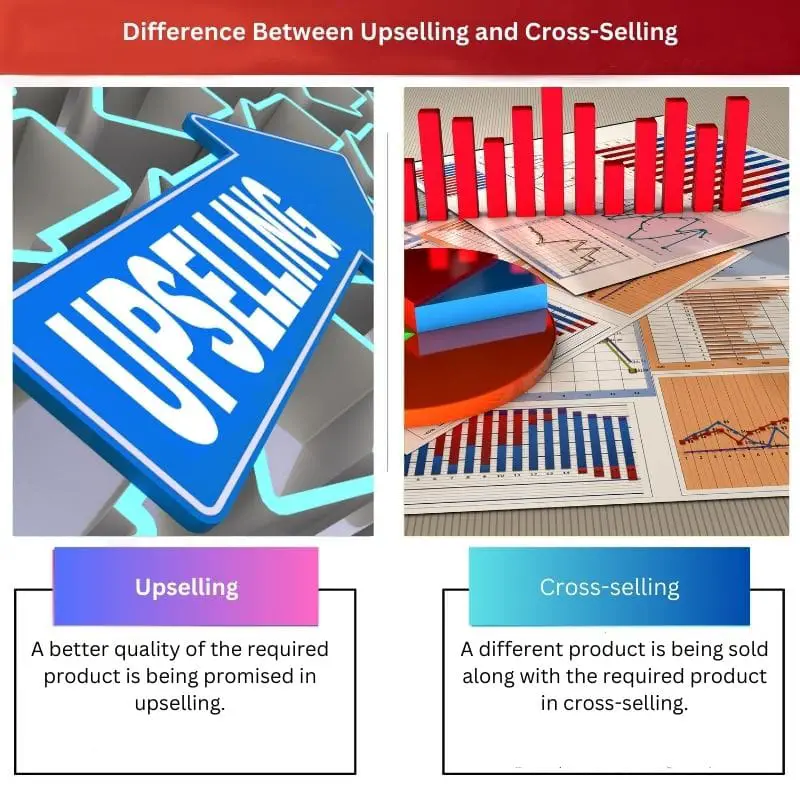Upselling involves encouraging customers to purchase a more expensive version of the product or add premium features to their current selection. Cross-selling, on the other hand, suggests complementary products or services to enhance the customer’s overall experience, often leading to the purchase of related items.
Key Takeaways
- Upselling is a sales technique where a seller encourages a customer to purchase a higher-priced item or add-on features to increase the value of the original purchase.
- Cross-selling involves recommending complementary or related products to customers and encouraging them to make additional purchases alongside their primary item.
- The main difference between the two lies in their approach: upselling focuses on increasing the value of a single item, while cross-selling aims to sell additional, related products.
Upselling vs Cross-Selling
Upselling refers to a sales strategy where a seller encourages a customer to purchase an upgraded version of a product or service or to buy additional products or services that complement their original purchase. Cross-selling is a sales technique that involves offering customers additionally.

Upselling, as the name suggests, is the increase in expected sales. When a customer intends to buy a product, the seller insists the customer check out for better quality.
Cross-selling is a similar sales pattern in which the seller convinces the buyer to buy a product that may not fit his heiress.
Comparison Table
| Feature | Upselling | Cross-Selling |
|---|---|---|
| Focus | Selling a higher-priced version of the same product | Selling complementary or related products |
| Timing | After the customer has shown interest in a product | Before or after the customer has shown interest in a product |
| Objective | Increase the revenue from a single sale | Increase the number of items purchased and overall sale value |
| Product Type | Upgraded, higher value version of the initial product | Complementary, related, or connected items |
| Example | Convincing a customer buying a basic laptop to purchase a premium model with better specs. | Suggesting a mouse, carrying case, and external hard drive to someone buying a laptop. |
| Impact | Increases average order value (AOV) | Increases total sales and potentially AOV |
What is Upselling?
Understanding Upselling
Definition
Upselling is the practice of convincing a customer to buy a more expensive item or upgrade a service, ultimately maximizing the revenue generated from a single transaction. This approach aims to enhance the customer’s experience while simultaneously boosting the business’s profitability.
Distinction from Cross-Selling
It is crucial to differentiate upselling from cross-selling. While upselling involves encouraging customers to purchase a higher-tier version of the same product or upgrade to a more advanced service, cross-selling entails suggesting complementary products or services that are related to the customer’s initial purchase.
Significance of Upselling
Revenue Growth
The primary objective of upselling is to increase the average transaction value, leading to higher revenue for the business. By enticing customers to invest in premium offerings, companies can enhance their financial performance.
Customer Satisfaction
Effective upselling involves understanding the customer’s needs and preferences. When done right, upselling can contribute to a positive customer experience by providing valuable upgrades that align with the customer’s requirements.
Building Long-Term Relationships
Upselling not only boosts immediate sales but also plays a crucial role in building long-term customer relationships. Satisfied customers are more likely to return, fostering loyalty and repeat business.
Effective Upselling Strategies
Know Your Customer
Understanding your customer’s preferences and buying behavior is essential. Utilize customer data and analytics to tailor upselling recommendations that align with individual needs.
Highlight Value Proposition
Emphasize the added value of the premium product or service. Clearly communicate how the upgrade addresses the customer’s specific requirements and provides additional benefits.
Timing is Key
Identify opportune moments during the customer’s journey to introduce upselling suggestions. This could include during the initial purchase decision or when the customer is considering complementary products.
Bundle Offers
Create attractive bundles that combine the initial purchase with relevant upgrades or complementary items. Bundle offers often present a compelling value proposition, enticing customers to opt for the upgraded package.
Challenges and Considerations
Resistance from Customers
Some customers may be resistant to upselling, viewing it as a pushy sales tactic. To overcome this, focus on transparent communication and demonstrating the genuine value of the suggested upgrade.
Finding the Right Balance
While upselling is beneficial, businesses must strike a balance to avoid overwhelming customers with too many options or aggressive tactics. A thoughtful approach is essential to maintain a positive customer experience.

What is Cross-Selling?
Importance of Cross-Selling
1. Revenue Generation
Cross-selling is a powerful revenue-generating strategy. By promoting additional products or services, businesses can tap into existing customer relationships, driving incremental sales and increasing the average transaction value.
2. Enhanced Customer Satisfaction
When done effectively, cross-selling can enhance customer satisfaction. Recommending relevant items demonstrates a deep understanding of customer needs, fostering trust and loyalty.
3. Cost Efficiency
Cross-selling can be more cost-effective than acquiring new customers. Leveraging existing customer relationships reduces marketing expenses, making it a financially prudent strategy.
Strategies for Effective Cross-Selling
1. Customer Segmentation
Segmenting customers based on their preferences and purchase history enables businesses to tailor cross-selling efforts. This personalized approach increases the likelihood of successful recommendations.
2. Product Bundling
Creating bundles of related products or services encourages customers to make a comprehensive purchase. Bundling often provides cost savings, making it an attractive proposition for customers.
3. Utilizing Data Analytics
Leveraging data analytics allows businesses to identify patterns and trends in customer behavior. This information can be used to predict potential cross-selling opportunities and optimize marketing strategies.
Challenges in Cross-Selling
1. Resistance from Customers
Some customers may perceive cross-selling attempts as pushy or intrusive, leading to resistance. Balancing promotion with sensitivity to customer preferences is crucial to overcome this challenge.
2. Ineffective Recommendation Systems
Poorly implemented recommendation systems can hinder cross-selling efforts. Investing in advanced algorithms and technologies ensures accurate and relevant suggestions.
Real-world Examples
1. E-commerce Platforms
Online retailers often employ cross-selling techniques by displaying complementary products during the checkout process. Suggestions like “Frequently Bought Together” capitalize on the customer’s current buying intent.
2. Financial Services
Banks and financial institutions cross-sell by offering customers additional services, such as credit cards, insurance, or investment products. This diversification enhances the overall customer relationship.

Main Differences Between Upselling and Cross-Selling
- Definition:
- Upselling: Encourages customers to purchase a higher-end or more expensive version of the product or service they are considering.
- Cross-selling: Involves offering additional products or services that complement or enhance the item the customer is already interested in.
- Focus on Value:
- Upselling: Emphasizes the added value or premium features of a more expensive option.
- Cross-selling: Focuses on providing additional value by suggesting related or complementary items.
- Product Relationship:
- Upselling: Involves suggesting an upgrade or premium version within the same product category.
- Cross-selling: Suggests products from different categories that enhance the customer’s overall experience.
- Customer’s Initial Intent:
- Upselling: Assumes the customer is interested in the primary product but might be willing to spend more for better features or quality.
- Cross-selling: Assumes the customer may find additional products relevant to their needs, even if not initially considered.
- Goal:
- Upselling: Aims to increase the overall transaction value by convincing the customer to choose a higher-priced option.
- Cross-selling: Aims to broaden the range of products purchased by the customer, potentially increasing the overall order value.
- Examples:
- Upselling: Offering a more powerful laptop with upgraded features when a customer is considering a basic model.
- Cross-selling: Recommending a laptop bag, mouse, and antivirus software when a customer is purchasing a laptop.
- Timing:
- Upselling: Typically occurs during the consideration or decision phase of the customer’s buying journey.
- Cross-selling: Can happen at various stages, but often occurs during the checkout process or after the customer has made a primary selection.
- Customer Benefit:
- Upselling: Aims to provide the customer with a better or more advanced version of the product they are interested in.
- Cross-selling: Aims to enhance the overall experience by offering products that complement the customer’s primary purchase.
- Strategy:
- Upselling: Involves highlighting the superior features, benefits, or quality of the more expensive option.
- Cross-selling: Involves demonstrating how the additional products contribute to a more comprehensive and satisfying customer experience.






